The 1965 Gippsland Fires and APM Forests Pty Ltd (APMF) Involvement
Preamble - R McCarthy & O Raymond
One of the major private-sector forest companies to operate in Victoria for much of the 20th century was Australian Paper Manufacturers/APM Forests[1]; as both a consumer of native forest produce for paper-making from the 1930s, and as a plantation establishment and management organisation, initially in the 1930s, and in a major way from the 1950s.
More details of the company’s operations can be found on this site at the following link.
Following the release of Peter McHugh’s book 1965 Gippsland Bushfires, A Reconstruction of Events from February to March 1965 (Sale: the author, 2020), we were approached by former senior field supervisors of APMF to prepare (in conjunction with them) an article on APMF’s involvement in the 1965 fires in Gippsland.
They were disappointed that Peter McHugh had been unable to source much history of APMF during that time from Hancock’s (now the owners of APMF’s plantations in Gippsland).
This article describes the experiences of two officers of APMF – John Dargavel, Planning Officer, and Ned Missen, Senior Field Supervisor – on the role played by the company in helping to combat major bushfires that burnt nearly one million hectares across Gippsland in 1965. John also provides additional insights into the company’s Gippsland operations in the mid-1960s.
Although the 1965 fires were insignificant in terms of plantation loss to APMF (some 300 hectares), the resultant outcome was the recruitment of Oliver Raymond who later became the Company’s Fire Protection Forester. This led eventually to APMF becoming recognised globally as the lead industrial plantation company fire organisation in Australia, especially in Central Gippsland and the Latrobe Valley.
Memories of the Bushfire at Stockdale, 5–9 March 1965 - John Dargavel (March 2020)
I have been asked for what I can remember about fighting the bushfire at Stockdale all those years ago. An account of the extensive Gippsland fires, of which the Stockdale fire was a part, has recently been published by Peter McHugh (see reference above). McHugh focuses on the Forests Commission’s activities and acknowledges that CFA groups and a private forestry company, APM Forests Pty Ltd, were actively involved. Before recording my memories of the fire, I note some personal context for my involvement.
Context
I worked as a forester for APM Forests Pty Ltd in Gippsland from 1958 to 1978. I started as an Assistant Forester working in the company’s Central Division, under Max Calsaferri. I was based in the Maryvale office, adjacent to the parent company’s pulp and paper mill. After a year or so, I took over from Murray Goudie as the District Forester for the Eastern Division, with an office in the company’s measuring station in the Bairnsdale railway yard. I looked after the Sarsfield, Wy Yung, and Stockdale Tree Farms. Sarsfield and Wy Yung were native forest areas, while Stockdale was primarily a plantation development. All the company’s tree farms were developed on private land purchased by the company (the lease of state land in the Strzelecki’s came later).
I should note that although the Sarsfield area was burnt in the 1965 fires, as it was again in 2020, by then the company no longer had property there. The company had decided to get out of its native forest management program in East Gippsland because the early promise of coppice growth and regeneration had been not been maintained. Further, the properties kept getting burnt out by the neighbours while, concurrently, property prices were rising quite strongly in the region.
Stockdale Tree Farm was the youngest of the company’s tree farms and was being developed as a pine plantation. Although it was the furthest of the company’s plantations from the Maryvale Mill, the land was available. Any pulpwood on the new blocks was cut; the land was then cleared and planted with pines. The headquarters consisted of three houses, a few single-men’s huts, and a work shed/garage. Trevor King was the foreman with a crew of about six when I was there. Trevor may not have been there by the time of the 1965 fire however.
The company was keenly aware of the risk of fire to its plantations, which were insured against it. It followed much the same establishment and management practices as the state forest services, but in its own energetic and forthright manner.
The company had five fire towers (Mt Taylor, Longford, Flynn, Silver Creek and Boola) that enabled watchers to call in signs of smoke to the fire control room in the Gippsland Office, where the sightings could be triangulated to locate any fire. I can’t remember whether the control room communicated by radio or phone, and I am not clear about whether the Forests Commission or the company was responsible for the Mt Taylor and Boola towers and their staffing.
Like the other foresters, I took my turn in manning the fire control room at weekends and public holidays during the fire season, and at Christmas when I was single. I also went fire spotting from a light plane hired from the Latrobe Valley Aero Club. The Gippsland office and most of the company’s field vehicles and cars were fitted with two-way radios, linked to the base repeater station on top of the Strzelecki Hills. Coverage was poor in hilly areas and the further away you went; hence it was patchy at Stockdale and worse further east.
Lyell Hill, a NSW graduate of the Australian Forestry School with the most imaginative colloquial vocabulary that I have ever heard, was the company’s fire officer. He had a dedicated central fire crew of two or three with Billy Hill as foreman. Lyell led the company in developing its own fire engines painted in a distinctive yellow. Each tree farm had one (Longford may have had two). Their crews were trained, and an annual inter-tree farm competition had been started, probably only a year or two before the Stockdale fires. The company equipped all its other vehicles with backpack sprays and McLeod rakes; like others I also carried an axe and spade in the boot of my vehicle.
The plantations were laid out with half-chain [10 m] wide firebreaks between compartments and one-chain [20m] ones for major internal roads and around the boundaries. These had to be ploughed each year. Fire dams were excavated in places to provide water where tankers could refill.
By 1965 I had been moved back to the Gippsland Office and been made responsible for developing the company’s measurement and long-term planning systems. This was a period of intense activity as both the parent company, Australian Paper Manufacturers, and its subsidiary were expanding rapidly. For several years I was also responsible for the Flynn Creek Tree Farm with Norm Strickland as foreman, a small crew, and headquarters etc. The older parts of the plantation were having their first thinning which proved very difficult in winter due to the boggy soil in parts of Flynn. Ex-car salesman, Garth Hackford was the most unlikely bush boss for Crawford’s, the harvesting contractor. One day sticks in my mind. I had gone to chase him up about his tardy deliveries. ‘…You must be kind, you must be pleasant…, John’, he said as he waddled up with a smile that completely defused me.
Reflecting on those times, I don’t think that there was any formal training in firefighting. You had to learn from people with experience or just by trial and error. My training in Scotland was limited to noting the birch broom beaters that were kept at the gates of some forests in heathy country. When I worked for the Woods and Forests Department at Myora Forest in South Australia, my boss, Jim Hancock organised a fuel reduction burn in a bush block adjoining the plantation. He and the other forester there, Roger Bungey explained how it was to be done. I particularly remember Jim showing me how to check that a burnt stump was fully out by putting your hand down into it.
With APM Forests, I went to a couple of small fires, and then found myself in charge of fire crews in the Eastern District. An important experience there was trying to extinguish a fire one evening in one of our regenerating blocks. There were four or five of us working with hand tools and putting it out quite successfully when we found that the local CFA group was lighting up on the side of our safe ground. They knew perfectly well that we were there, but the locals disliked having a forestry company around, ostensibly because wallabies came out of our forest to eat their grass. It was a lesson that I remembered well in 1965.
I learnt about the awesome power of fire from the times when we burnt the stumps, slash and small trees that had we had heaped up in long ‘windrows’ as we cleared the ground for a new plantation. They had to be left to dry, sometimes for a year or so. We would make sure the boundaries were ploughed and then on a good day we would call on some tankers and crews from another tree farm and light all the rows. As the fire in all the rows took hold, they could create a fire vortex that carried burning branches and even billets high into the air.
The 1965 Fires
The Gippsland fires directly affected the company from Friday 5th to Tuesday 9th March. I can never forget the dates because they are inscribed on a beer mug whose origins I will note at the end of these reminiscences. I do remember 1965 being a very hot, late summer, and for some time we had been aware of large fires burning in the hills north of the Latrobe Valley. As on other days of high fire danger, work was arranged so that the fire crews had their tankers near them. As the general fire danger rose, the possibility of a major fire in one or more of the tree farms increased. The greatest worry was that a fire might spot over the Latrobe River and into the largest and oldest plantation at the Longford Tree Farm.
I think that we may have had a fire in the Silver Creek Tree Farm, and presumably dealt with it. However, I do remember the difficulty of deciding which crews to send to the Stockdale fire when it broke out, and which to keep back to look after their own areas and the Maryvale Mill itself. In the event I think that the Silver Creek crew was kept there with their very able foreman, Jack Work.
I went to the Stockdale fires on two days and remember listening to the company’s radio on the drive up there from Traralgon. What I remember strongly is the confusion about where the fires were, a sense that new fires were springing up, perhaps from spot-fires or, perhaps also, from farmers doing some back-burning of their own. On top of this, a state of emergency had been declared and I saw military vehicles. We had no way of knowing what the military would do, and I felt that they might make fire-fighting more difficult.
Thanks to recent information from Ned and Judy Missen, I now know that I collected Ned, John Morgan and Geoff Tyers in Traralgon; and thanks to the information in Peter McHugh’s book I realise that it must have been on the morning of Saturday 6th. Why us four? I think that it was a case of ‘all hands on deck’. I was one of the foresters not already involved, and I knew the area. John Morgan had been one of the Assessment crew, but may have moved on to tree farm work, perhaps as leading hand in Maryvale Tree Farm. I can’t place Ned. Geoff in time was to become a chainsaw and safety instructor.
Some part of the company’s fire-fighting effort had been involved from Friday 5th assisting to fight fires outside the company’s land. (There were legal difficulties about this as we weren’t covered by the Forests and CFA Acts, but I think some solution was eventually found). Lyell Hill had moved to the area to take control on Friday. By Saturday morning, several tankers and crews were already there in addition to Stockdale’s tanker and crew. There was also a tank and pump on the back of a light truck. I associate this with the Assistant Foreman, Bob McNaught, and it may have been his personal set up as he had a small farm adjacent to the plantation. He was a very well-respected, married man in his fifties with a farming rather than forestry background. I think he joined the company after my time in charge of Stockdale.
When we drew in at Stockdale headquarters, the fire was just about to, or had already entered some part of the plantation on the western boundary. I cannot remember quite when or how we knew that a small spot-fire had started in one compartment. I drove there, presumably with Ned, John, and Geoff. I wonder if someone from the Stockdale crew came with us. We all had fire rake hoes that I think we must have collected from the Stockdale shed.
When we arrived at the compartment, I found there was a small fire burning inside the stand near the edge of the firebreak. The stand must have been about nine years old. It was unpruned and had a dense closed canopy whose base had lifted to about head height. Visibility was poor due to fact that most of the trees’ dead and branches and twigs were still on the trees. There was a matt of dry pine needles on the ground. Although there was a strong wind outside, there was hardly any wind within the stand. I could not determine how far the fire extended into the compartment, but as the flame height was low — perhaps up to half a metre — and was not causing a crown fire, I decided to start working along it immediately with a hand raked line with the aim of containing the fire to a small area before it could crown. We worked steadily on this line and were making good progress. The absence of wind within the stand remains firmly in my memory.
I cannot remember how we got the message to evacuate. Someone must have come and told us to go immediately to the safe ground of Bob McNaught’s farm on the edge of the plantation. Coming out of the shelter of the compartment I realised the urgency of the message. The wind was strong, and a large active fire was not far away. When we arrived our four or five tankers and about twenty men were there. His farm consisted of a gently sloping cleared paddock of about twenty hectares with his wooden house in the middle. He raised cattle on it, but there were none there that day. He had let them graze it bare, no doubt as protection for the house. I think that his wife was still in the house, although we did not see her.
The fire came out of the forest block on the western side of the farm. It was a crown fire which in the strong wind seemed in my memory to have had fire storm characteristics. In the event there was nothing to burn on paddock and the fire burnt straight across it. The ground was so bare that we had little difficulty in putting the fire out, except for the smouldering balls of dung which were being blown about by the wind. Two or three of the tankers worked hard to protect the house. Afterwards it seemed a miracle to see that this flammable wooden cottage was still there. I have no recollection of what I did later that day. My wife, Ricki remembers me returning home exhausted. I returned on a second day but have no recollection of what I did.
Later I would have been involved in mapping the area of plantation that had been burnt — probably about 300 hectares out of about 3000 in the Stockdale Tree Farm. This would have formed the basis for the insurance claim. Then I would have estimated how it would affect the long-term plan to supply pulpwood to the mill.
I think it was to the company’s relief that the insurers were glad the claims had not been larger thanks to our fire-fighting efforts. At the next annual fire-crew competition, the insurance company presented everyone who had fought the fires with a handsome beer mug individually engraved. That is how I can never forget that the Stockdale fire was in March 1965, fifty-five years ago.
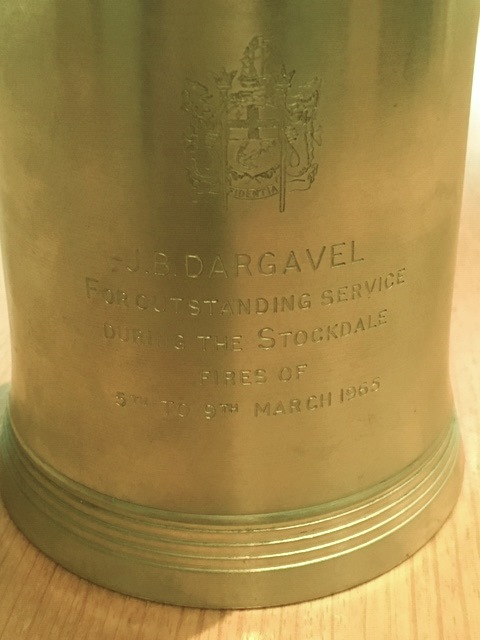
My Memories of the Gippsland ‘65 Fires - Ned Missen (March 2020)
As I finished work at the Flynn Tree Farm, I was possibly thinking of what I could do over the long weekend. Back in those days, I drove a small John Deere bulldozer that was equipped with a rotary slasher. I drove between the rows of pines clearing out the scrub and undergrowth to give easier access for the men with the chainsaws to cut the pines.
APM Forests had the weekend planned for me. I was transported immediately to the pine plantations at Munro-Stockdale. The other men from the Flynn Tree farm were John Dargavel - District Forester, John Morgan – Foreman, and Geoff Tyers. A Bedford tanker from Flynn went with us. John Morgan drove the tanker; I operated the pump and Geoff was on a hose. Crews from Longford and Munro had spent weeks trying to control the fires in the hills northwest of the Stockdale pine plantations. But now because of worsening weather conditions the pine plantations were threatened. APM forests brought men from wherever they could get them. All their employees were in the Munro Stockdale area except for one tanker crew, which was held at Flynn Tree farm in case a fire should start in that area. As well as their employees, there were Maryvale mill employees, F.R.I. (the Commonwealth Forest Research Institute) employees and APM Forest contractors.
APM Forests I guess had fifteen fire tankers at the fire. I am not sure of the numbers because I had only been employed by the company, at that stage, for three months. APM Forests also had bulldozers at the fire; D6s, D7s, and timber-jack. Gordon Davis, who was an APM Forests contractor, was at the fire with his Case bulldozer and low-loader. Gordon was a terribly busy man and he was in big demand as his machine was very versatile.
The company’s tanker fleet consisted of two Austin’s and a few International 4 X 4s.
There were two International 4 X 4 tankers and for the first night John Morgan was the driver, while I manned the pump and Geoff handled the hose. The fire-fighting was desperate; we seemed to rush from emergency to emergency. I remember a spot-fire starting 300m inside a block of pines; it was 3 m to 4 m high. The first call was for knapsacks and rake-hoes and then a call to run a rubber line hose to the fire.
John Dargavel said that truck will go over those pines, so John Morgan drove over the pines to the fire and I stayed on the pump-deck. We put the fire out and drove over more pines to get back to the road. If the truck had of been reversed it would have been damaged. After fighting several fires all night somebody said the sun is coming up. I was completely turned around and I looked to the west. All APM fire tankers had a trunk of food consisting of tinned food, dry biscuits, and condensed milk to name a few of the items. John Morgan, as well as driving the truck heated tins of sausages and vegetables on the engine manifold. We were able to have something to eat while we worked.
It was now Saturday morning, but I was required to continue fighting the fires. I was now required to drive an Austin fire tanker and was given a crew member but I do not remember his name. We were directed to a section of the pine plantation boundary where a fire was approaching. I was in the truck and the crew man had a hose laid out and he was putting out a section of fire. He called to me there is no water. I had previous experience with this old truck, and I knew what the problem would be.
This old truck had a rusty water tank and the fire-gun nozzle was blocked with rust flakes. I ran to the end of the hose to show the crew man how to unscrew the fire-gun and let the water flush out the rust. Before I could do this, the wind changed and blew the fire toward us. I ran and jumped in the driver’s seat, but the truck engine had stopped, and it would not start. Flames were licking the driver’s door when I slid across the seat and I leapt out onto the firebreak and ran to safety. I glanced back at the old truck and it was enveloped in smoke and flames. Suddenly the wind changed, and it swept the fire away. The old truck was standing there with the pump engine still running and the only part that caught fire was the hose laying on the ground. I finished unscrewing the fire gun, the water gushed out. I put my thumb over the end of the hose, and I sprayed water along the burning hose. This put the fire out.
During some of this time the Gippsland manager was close by and he gave me advice and encouragement. I wound up the hose on the back of the Austin and when I got back into the driver’s seat, I pushed the starter button and the engine started. Later, the wind became extraordinarily strong. I had a Maryvale mill employee called Bluey Donavon and we were standing on the firebreak downwind of the Austin tanker. This extreme wind picked up the crosscut saw from the top rack of the tanker. The saw came towards Bluey and I, the teeth of the saw bit into Bluey’s hat taking it off his head and carrying it several metres up the firebreak.
I think there was a lot happening at this fire that I did not see because it was very smoky. I saw Gordon Davis leap off his bulldozer because the flames got too close but I saw him get back on his bulldozer and continue with his good work.
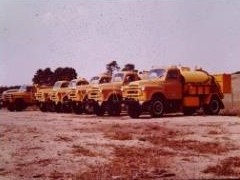
APMF Fire Competition line of 700-gallon fire-tankers, November 1965
Source: Phil Inger, APMF
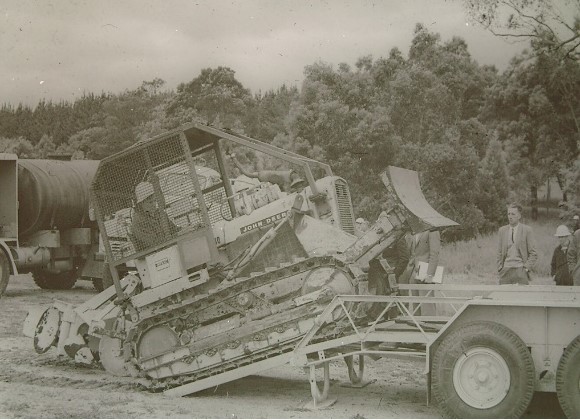
Ned Missen, 1965
Source: APMF
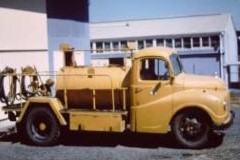
APMF Traralgon Fire Store #1 - V8 Superseded Austin A49 with Grazo’s Pump, 1965
Source: Phil Inger, APMF
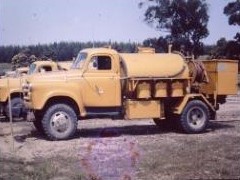
APMF International 4 x 4 700-gallon fire-tanker, 1963
Source: Phil Inger, APMF
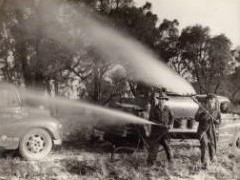
APMF Fleet # 86 & #1 Austin tankers demonstrating high pressure pumps and tank units, 1965
Source: Phil Inger, APMF
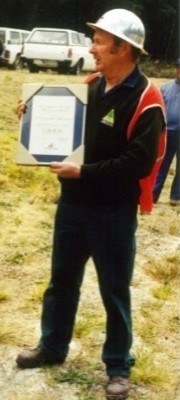
Ned Missen, 1998
Source: APMF
My next job - I was put in a Land Rover with two FRI employees and three Homelite chainsaws. They took me along the edge of where the fire had burnt to and there were several burning trees. Most of these trees were green and burning on the inside. It was my job to fall these trees onto the burnt area to prevent them spreading sparks onto the unburnt area. I had difficulty getting some of these trees to fall the way I desired. One tree sat back, closed the saw cut and held the chain saw. Flames were coming out of the saw-cut on both sides of the chainsaw. I quickly grabbed another chainsaw, I did plunge cuts to cut out a block above the first saw, and it was released. I was surprised to find the saw was okay and I could still use it.
I thought APM Forests did a great job saving its pine plantations. My recollection was they lost about 150 acres of the Munro Stockdale plantations. They had a 200 acre plantation at Sarsfield and all of it was burnt because nothing was done to save it.
From the time I first started at Flynn on Friday morning I had completed 33 hours of fire-fighting. I was given 8 hours rest followed by 16 hours at the fire, 8 hours rest, 16 hours at the fires, 8 hours rest and another 16 hours at the fire. My effort at the fire was finished. I felt absolutely exhausted. I bet I was not the only one.
(1) In 1986 APM became AMCOR, which in turn was bought by the Nippon Paper Group in 2009. In 2020 Nippon launched the company Opal.
